It is that time of year again, spring has sprung, and it is time to repaint your pool. We are here to help you learn everything you need to know about repainting your pool.
Testing to Determine Pool Paint Type
It’s very important to repaint the pool with the same type of paint used before. If the pool was painted with epoxy, repaint with epoxy paint, and if rubber-based paint was used, then go over it again with rubber.
If you are not sure what paint is on the pool, test a paint chip by dissolving in epoxy or rubber based solvents, or use acrylic (see below).
- Use rubber or epoxy pool paint solvents.
- Chip off a small piece of the pool paint.
- Rub the chip in a few ounces of one of the solvents.
- If it starts to dissolve within about a minute in one solvent while rubbing, it is that type of paint. If not, it’s the other.
Pool Paint Solvents
A solvent is a liquid that can dissolve other substances. It’s not a complete or rapid dissolve but only lightly affects the surface. You’re looking for a surface chalking on the paint chip, or for softening and smudgy removal on pool wall test areas.
1. Denatured alcohol dissolves acrylic pool paints
2. Xylene (Xylol) dissolves rubber-based pool paints
3. Butanone (MEK) dissolves epoxy pool paints
Paint Chip Test
Clean the paint chip of any oils or dirt, and drop it into an ounce or two of the solvent for approximately 30 seconds. Observe the chip for surface action, like a cloudy haze or micro bubbles on the surface. Remove with tweezers and wipe with a cotton ball or paper towel to see if the paint will rub off easily.
If the paint gets soft and smudgy, you have found your pool paint type. If it’s not soft or obviously dissolving, you can move onto a different solvent, and so on, until you find the one solvent that definitely dissolves the paint. To be certain, perform the test with another chip, to confirm the results.
Wall Paint Test
Clean the wall area to be tested with TSP, Simple Green, or just soap and water, to remove any grease or oils from the surface. When dry, use a cotton ball or paper towel to apply the solvent directly onto the painted surface in a vertical area of about 6-8 inches long and 1 inch wide. Rub the area with an up and down motion, and after half a dozen passes, if you don’t feel the paint becoming soft and sticky, move to an untested area and repeat the test with a different solvent type.
Use enough solvent to saturate the cloth, but not so much that it will drip off. When you think you have found your solvent and thus your paint type, repeat the test in another area, just to confirm the results.
Switching from Rubber to Epoxy
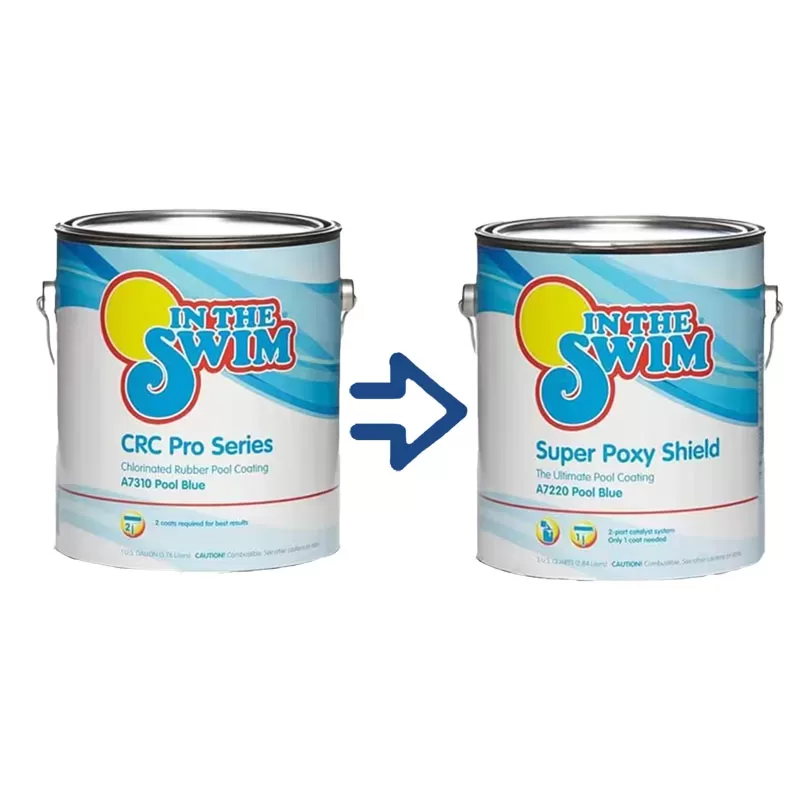
In the old days, you had to sandblast the pool to remove every trace of rubber paint, before you could repaint with the longer-lasting epoxy pool finish. Now, you can use Advance Plus conversion paint as a primer, and then paint over with any Epoxy pool paint!
Epoxy pool paint is more expensive than rubber based, but it can last up to 7 years, wearing thin over time. It also produces a hard, ceramic-like finish.
Acrylic enamel is a water-based pool paint, so the surface doesn’t need to be completely dry before refilling the pool, which can save days on your pool painting project. Acrylic paints, however, have a shorter lifespan of 2-3 years, compared to 5-7 years for epoxy. It may outlast rubber-based paint, however, which may only last for 1 or 2 seasons.
Now you are ready to paint your pool, make sure to let the coating cure for the recommended amount of time then enjoy your swimming season in your beautifully repainted pool!
Painting a Previously Painted Pool
The pool prep is exactly the same as for a non-painted pool, only it should go a bit faster. Check the label for paint specific instructions, but the general procedure is:
After the pool is dry, according to the label, it’s time to repaint your pool! Remove the pool light, clean the pool and pool deck with a blower, broom or wet/dry vac to remove all debris before you start painting, and check the weather forecast for rain or heavy winds. Start in the deep end with a 5-gal bucket and a roller, and apply the new paint. Corners and steps can be cut-in with a small roller or brush.
Allow the pool some dry time, according to label, and then start filling! See our full selection of pool paints and pool painting supplies, and get started!

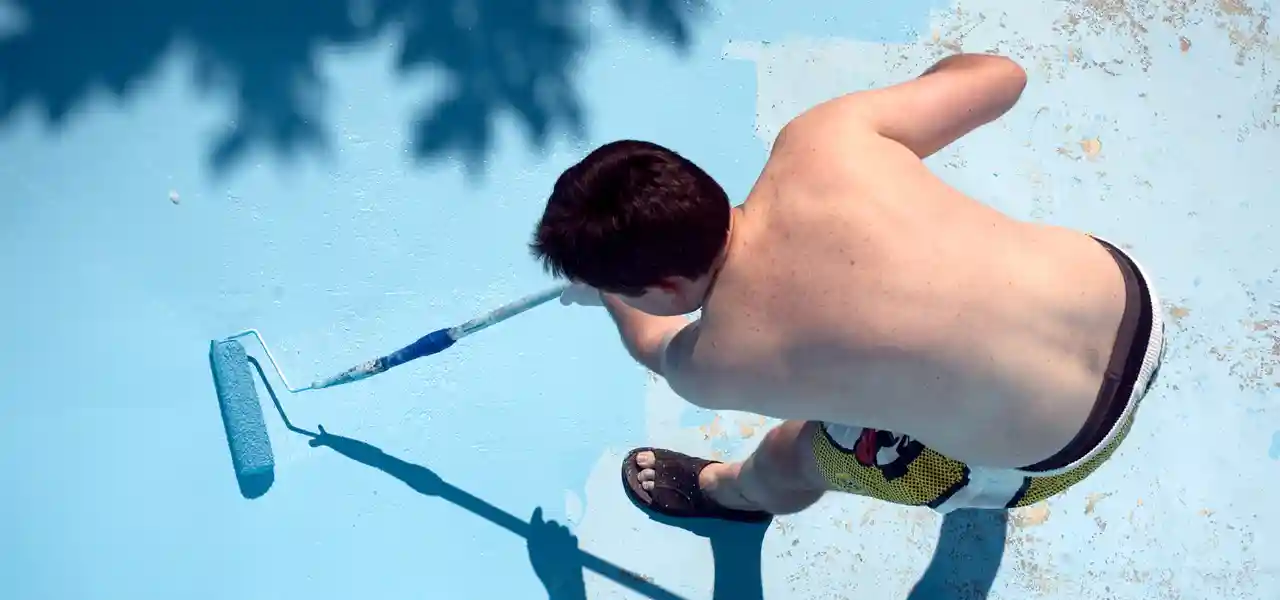
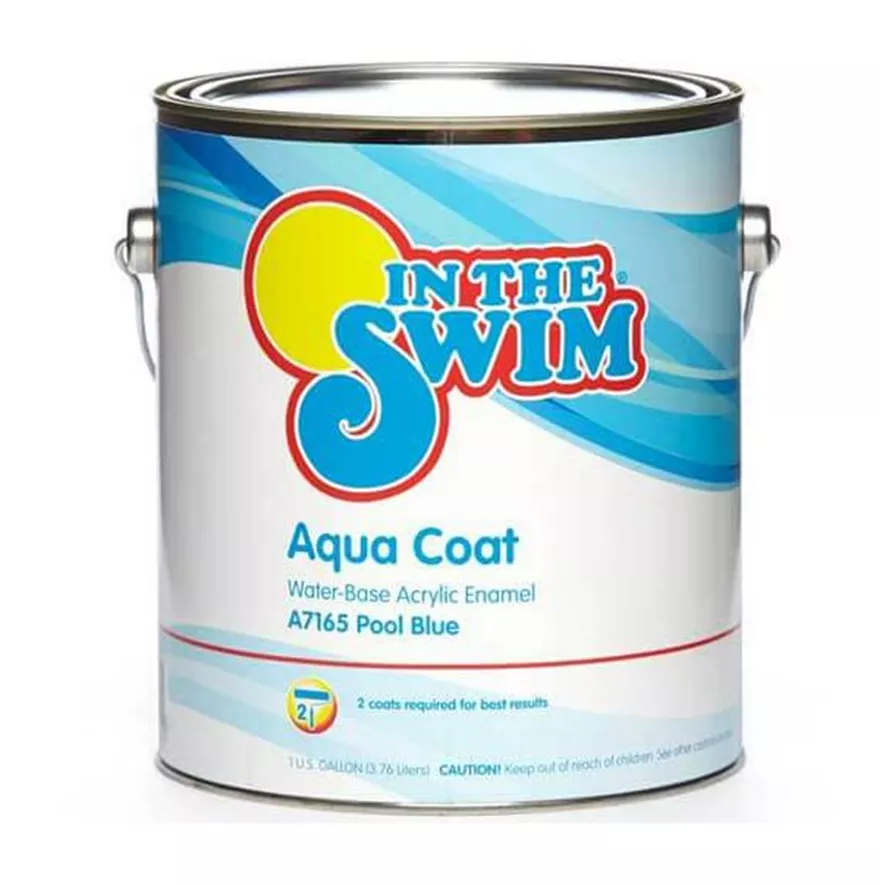
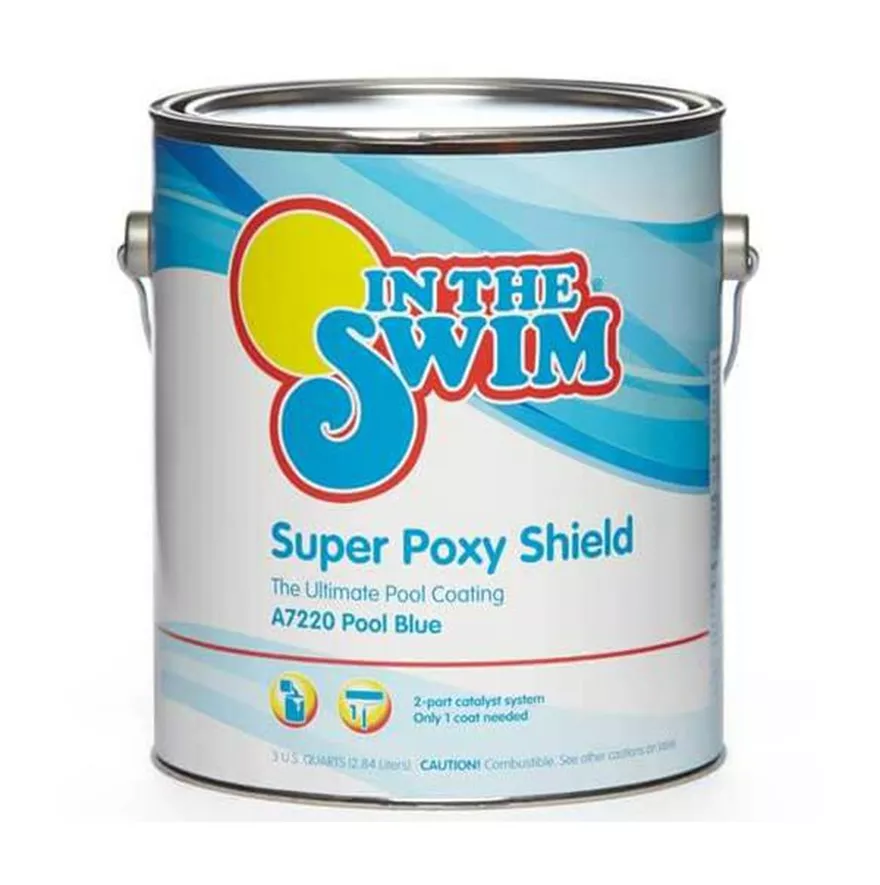
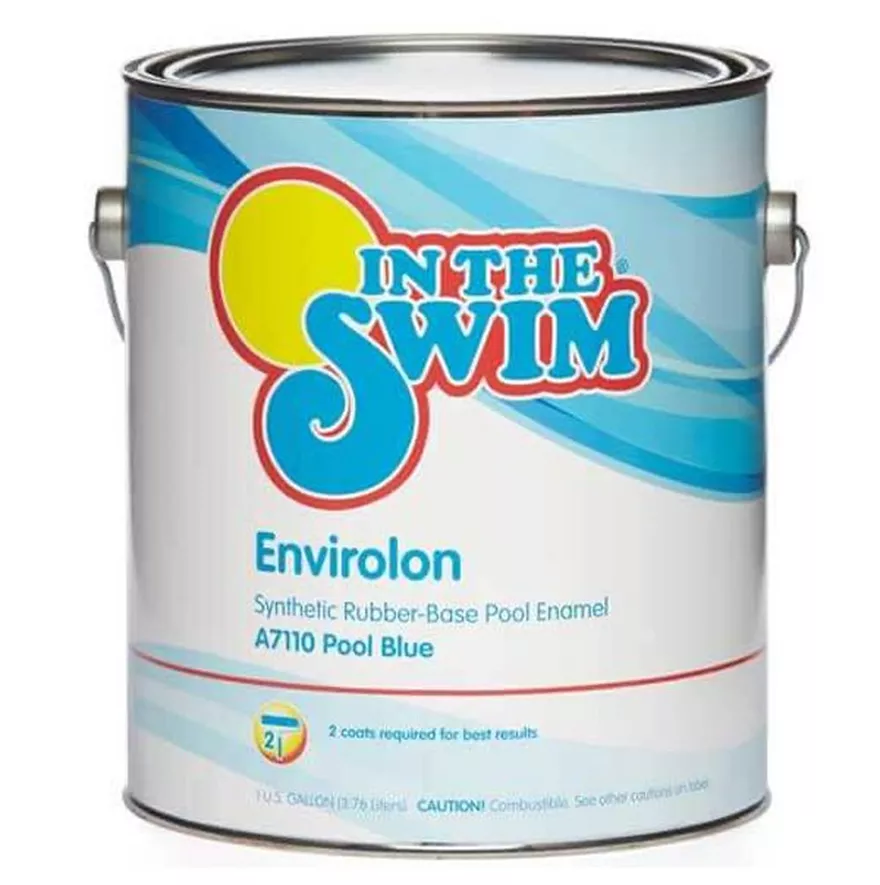

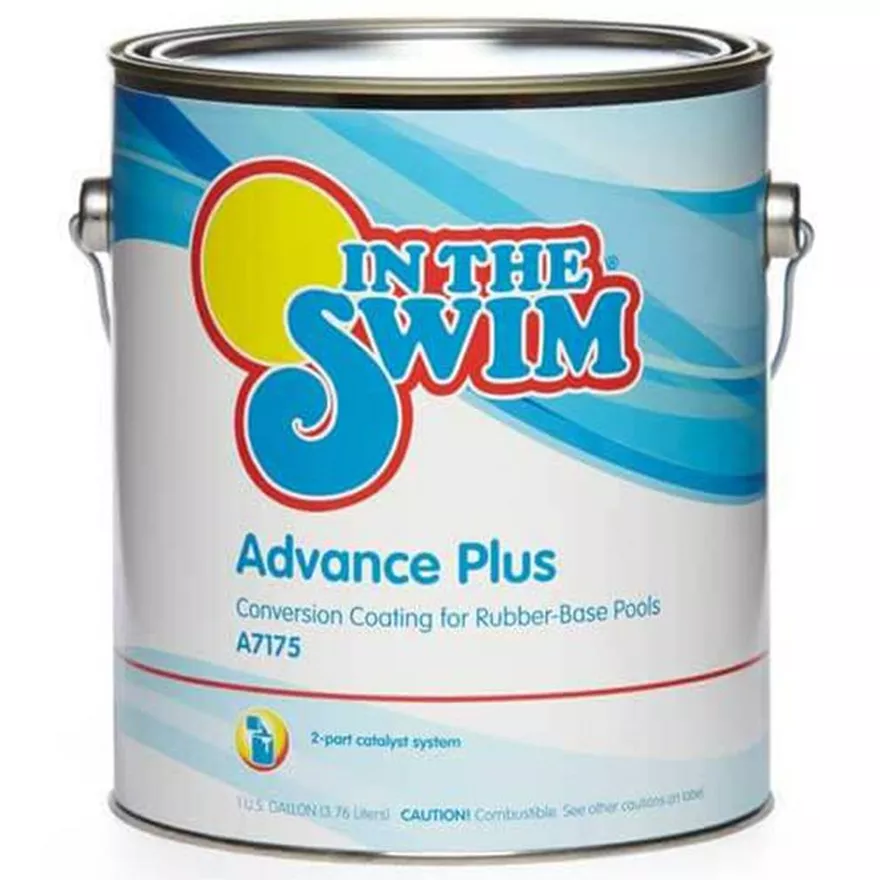
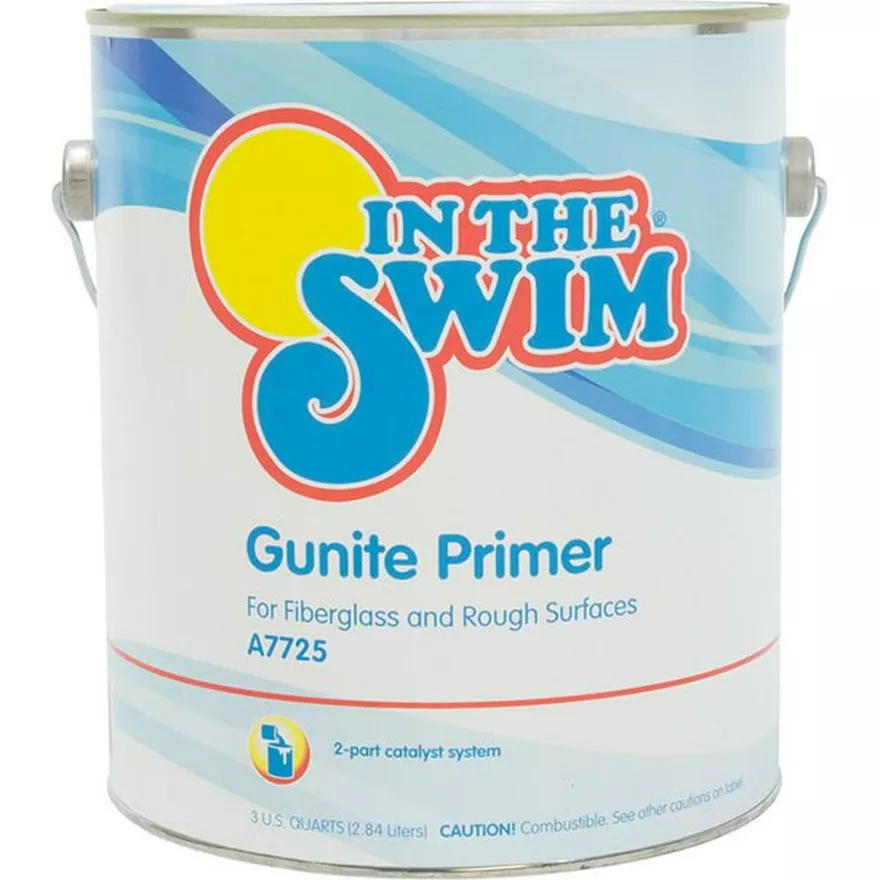
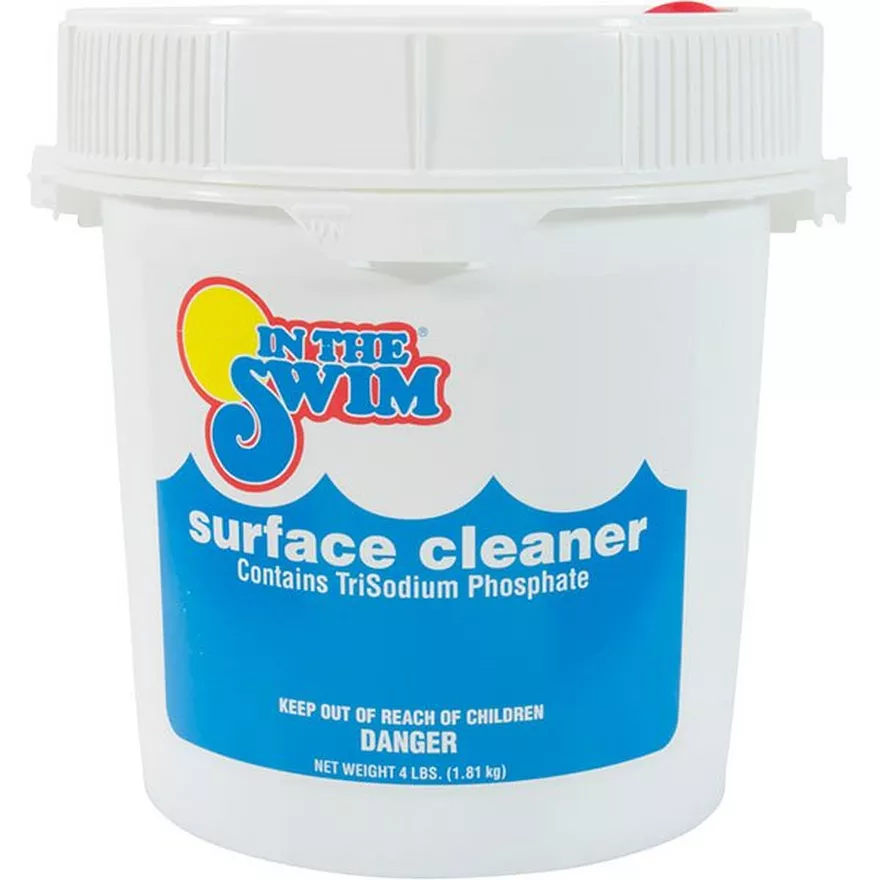

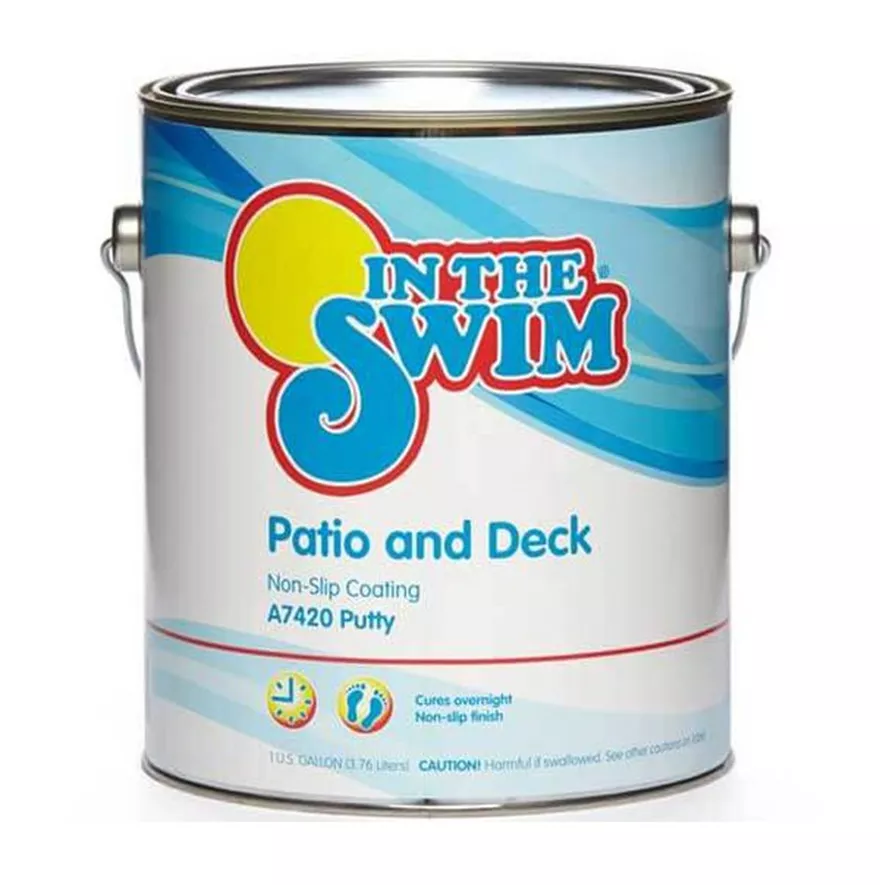
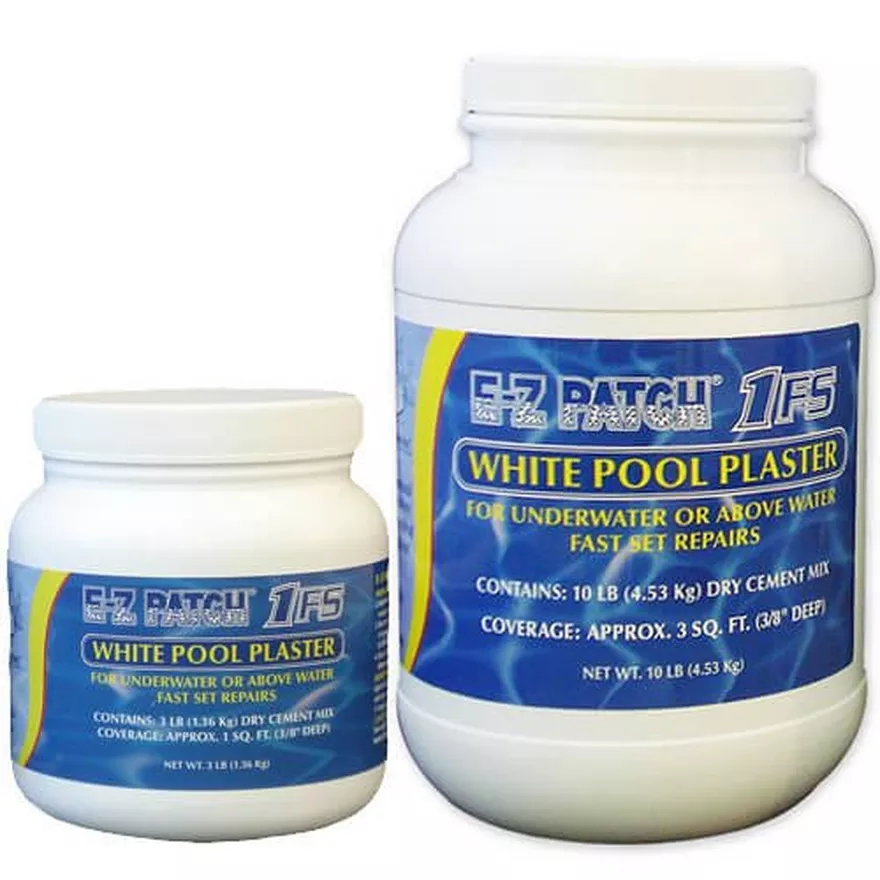
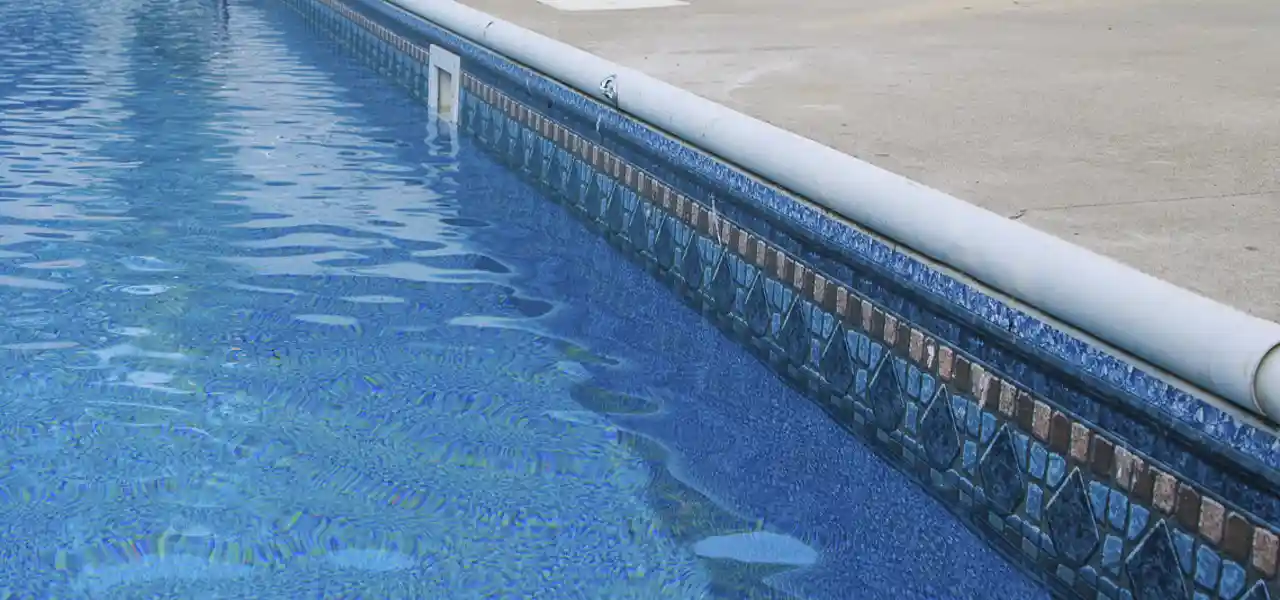
How do you get the pool dry by the drain. We have pumped everything out but seems like a little water wants to seep back up. Thanks
To get the last bit, remove the drain cover (don’t lose the screws) if your pump does not fit in the drain hole you can use a shop vac to suck it up, then put your pump in the shop vac tub, and pump it out when full. Or you can use a scoop and a sponge and a 5-gal bucket, if it’s not very much water.
I had my spa epoxy painted. It has a very rough surface, uneven and bumpy to the touch. What do I need to do now to fix it?
Epoxy paint does not normally produce a rough surface, but perhaps those are fibers from the fiberglass, or was a ‘splatter coat’ of paint applied? Or non-skid sand added? Or are these bubbles/blisters in the paint? If you think it may help you could use sand paper, or a small handheld electric sander, to do the seating surfaces. It of course will dull and scratch the paint and not look any better, but may feel better to the touch. After sanding, you could repaint those areas if you wanted.
Thanks. I have resanded the spa but I’m worried when I go to paint it again it will still blister. How do you prevent that from happening again?
Hi Jon, paint blisters are usually cause by either 1) poor surface prep and oil/scale/dust on the surface, or 2) moisture in the shell of the pool or spa, not fully dry, or 3) painting a hot shell in the heat of the day. With fiberglass, it can also be trapped gas, which is usually only a problem on new spa shells.
Do you need to seal after painting with Acrylic?
Hi, there is no sealer that is used on pool paints, not one that I am aware of anyway.
I have a very old concrete pool that has many layers of paint chipping off. I was planing on painting in the fall but some friends said they were concerned to have there kids swim in the pool because they believe there is lead in the old pool paint. Should I be concerned about lead in the old paint layers contaminating the water?
No way! Lead stopped being used in paints in 1971, and I’m sure your pool has been painted probably ten times since then! 🙂
We have a concrete fiberglass pool. When we bought the house we had to do some repairs on the pool and the paint was chipping. We bought the pool paint only to find out that this is now chipped all over the place because our pool previous had epoxy on it. So we have not drained the pool and trying to get the home depot paint off the walls is horrible. Any suggestions on how to remove this paint a little faster? I think the pool paint is latex but I am unsure. Thanks!
Sandblasting or bead blasting is the best way to remove the paint. A powerful pressure washer can also be used.
Can I paint over a epoxy painted pool with acrylic paint if acid washed very well?
The epoxy is old.
Hi, yes you can coat over epoxy with acrylic paint. In addition to acid washing to remove scale, do a TSP wash, to remove oils.
If I have a pool previously painted with acrylic paint can I prep it with “Advanced plus” and then paint with Epoxy paint??!!
Hi, yes you can do as you describe, Advanced Plus is a Conversion Paint that when used as a Primer over acrylic, allows you to coat again with Epoxy
if we prep the pool and primer it but run out of time or weather doesn’t let us finish. can we paint the following weekend. if so what do we need to do to get ready to paint the next weekend.
thanks,
wayne
Hi Wayne, You would be advised to sand the surface slightly to roughen up and remove the sheen on the first coat, if you are waiting longer than 12 hours to paint a second coat. Usually you can paint a second coat in 2-3 hrs, depending on temperature and humidity.
we have a 40+ year old pool with fiberglass walls and concrete floor. it was painted about 5 years ago with a epoxy paint. the sides started to chip so we have decided to repaint. we have cleaned the paint off the walls. I have ordered the epoxy primer and the super epoxy paint. but idk if it would be better to use the gunite primer. everyone has said the gunite primer is best for fiberglass.
thanks,
wayne
Wayne, you are safe to go ahead and use what you have. The Gunite primer is best for a never before painted fiberglass, but since you have some bits of paint on the wall, go ahead with the Epoxy primer.
Good afternoon Davy,
So much valuable advise above. I would be painting the pool walls with CR paint in the coming days; weather permitting.My question please! After the last coating how long must we wait to refill please?. Weather here is generally warm at this time of year. Grazzi.Leo.
Hi Leo, check the label on the paint can for their advice, but generally, a pool should dry for 3-5 days before refilling, depending on the weather. If hot and warm, 3-days, or if cool weather, 5-days. If you get rain during dry time, be quick to wipe it down, broom it down, blow it down… to the deep end and suck it up with a sponge or shop-vac, and add an extra day of dry time.
We have an Inground vinyl liner pool. The polymer coping around the edges needs to be repainted. What do you suggest as far as type of paint to use. Any helpful tips would be appreciated.
Hi Rebecca, to paint vinyl pool coping – if you have the plastic type of coping, use Rustoleum Plastic, and if you have aluminum coping, use an Acrylic Enamel paint
Hello,
I have a 17 yrs old pool that I painted 3 yrs ago with acrylic and within 6 months had bad spots popping off. Now has a lot. I want to go back with epoxy, will sand the bad spots, if I paint over with advance plus do I need to sand blast and remove all the acrylic before I use epoxy? Want to switch to epoxy due to lasting longer.
Hi Harold, the Conversion Coating is for Rubber paint to Epoxy, but does not mention using it to convert from Acrylic to Epoxy, so I would have to say no – I have called the manufacturer and they have confirmed this 🙁 – so, sand blasting would be in order, or bead blasting – both are tough jobs to do. Sanding with orbital grinders may be another option. A third option I suppose is to try again with acrylic, this time with more aggressive degreasing and acid bathing, to avoid the pop-offs, and two coats for longer life. Even still though, most acrylic paint jobs only last 3-4 years tops, if you’re lucky. Good luck to you, Harold!
Hi there,
We are in the process of painting our fibreglass pool with epoxy paint and have done the first coat but after 48 hours part of it is still very tacky. Is it normal to take this long to dry or have we mixed this batch wrong and how long do you think we wait before starting to try scrape it off and start again on that section?
Thanks
Hi Harriet, it depends on the temperature and humidity. If it does not cure in a 2 more days, then you may have a mixture problem, or perhaps the wall areas were still moist in those areas, and not completely dry.
I am using Gunzite prior to Zeron. Rain is expected within the 48 hours time frame to coat with Zeron after the Gunzite. Will rain bother the adhesion factor on the Gunzite? Or can I just shop vac off the water and proceed with drying? Then paint when dry with the Zeron within the 48 recommenced hours.
Weather temps expected high 70’s Low 50’s.
Hi, get out there and start painting! It should be dry before 48-hours. Then yes, use a Leaf Blower to blow all the water to deep end, then use a shop vac (quickly!) to remove the water in the deep end bowl. After 2-3 days of good dry time, paint the Zeron.
Do I use a primer before I paint my pool? I sanded all the paint off. Bare plaster..
Hi Lawrence, we have two primers – one is basically an acrylic and one is epoxy. The acrylic can be used if you have moisture problems in the shell, or if you can’t get dry weather for a full 3-5 day drying of the pool. For a longer lasting finish, you could do one coat with the Gunite Primer, and a Top coat with the epoxy paint. The advantage of a primer is that it’s not as viscous as the epoxy paint, so it can get into small voids better, for a better overall bond. It also is 20% cheaper than epoxy paint, so allows you to reduce costs, if you planned to do two coats anyway.
Hello,
I am repainting my pool this year. Was going to sandblast old epoxy paint off but decided against it. Took a pressure washer to it and it took some chips off here and there. Should I just paint over those spots or do I need to primer the pool first? I’m thinking if just painting over the old epoxy, I shouldn’t primer correct? I am using the same type of epoxy paint as last time I painted 6 years ago.
Thanks.
Steve
Hi Steve, yes no need to use the Epoxy Primer, but I would sand down the edges of the chips, and then hit those spots with a small brush (or roller), to prime the bare spots and fill in the depression a bit, using your regular epoxy paint. After 2-3 hours of drying, roll paint over everything. Don’t skip the degreasing step, washing the pool with TSP and warm water, scrubbing and rinshing well – pressure washers (even acid washing) doesn’t always remove trace oils and greasy deposits, which paint has trouble bonding to.
Hello, we are getting ready to paint our pool. Coating is presently unknown. Deep end of pool is white smooth type surface that shows some checking, but not peeling. Shallow end has a coating on top of that, that is chalking/flaking off. The shallow end coating is gritty and comes off almost like a fine sand; it’s porous and has algae under it. Following removal of all the loose coating, is this a candidate for the conversion primer, then epoxy?
Hi John, that shallow end coat may have been the wrong type of paint. Epoxy will give the longest life, but only bonds to epoxy, or conversion coating. You can send a paint chip to Ramuc paints for analysis, or just use the conversion coating and then one coat of epoxy paint, after the regular prep and drying process.
Thank you Davy. I stopped by a trusted local pool store this morning with some sample bits. I was told that it may be a “Diamondbrite” type of aggregate material that was added over whatever the white coating is. They are checking with another local refinisher to see if they may have done it years agon. Either way I am assuming we should start with a pressure wash first?
Hi, Diamondbrite is a thin, cementitious coating that is rolled on, like very thin plaster. Pop-offs and delaminations are common. Yes, start with a scraper on pole and a pressure washer, pull up anything loose or hollow-sounding. You can paint over top of Diamondbrite, but just be sure it’s bonded well, conversion coating would not be needed, but can be used, assuming you have some areas of DB and some painted areas…
Can acrylic be painted over an old epoxy paint? Will it adhere?
Yes, it will adhere, if the surface is properly prepped according to label directions. Acrylic pool paints are the only paint that can be painted over other dis-similar paint types…
I want to repaint my fiber swimming pool. Do I first have to remove all old paint and then repaint or can i just wash the pool with acid and then paint.
Hi, no need to remove old paint, but removing scale and oils is very important. Follow the 3-step practice of TSP Washing (to remove oils), Acid Washing (to remove scale), and TSP washing again (to neutralize the acid, and remove any remaining grease). Loose or peeling paint should be removed, but not solidly attached. Be sure to paint with the same paint that was used before (rubber, epoxy or acrylic), as they are not compatible. Acrylic can be used over other paints actually, and there is a conversion paint primer to convert from rubber to epoxy paint.
When using a hi build epoxy paint to a gunite pool that has never been painted, would we need to apply 2 coats of paint ?
H i there – yes I would do 2 coats of epoxy, or one coat of epoxy primer and one coat of epoxy paint, which will be a little less expensive.
My pool was painted with epoxy paint 3 years ago. It has since faded in partial areas to the white thin layer of powder once paint faded out, some areas are fully exposed or bubbled etc. do I have to fully remove all paint before decorating with epoxy paint again? What are the proper steps to get this done right?
Hi Will, you do not need to remove all epoxy paint, just any loose, peeling or flaking paint. The entire surface should be prepped with TSP wash, Acid Wash, TSP wash, and then go over the peeling areas again with a 300-400 grit sandpaper, to knock down the edges, and scuff up the old paint, for better bonding. Details above…
I have used both rubber based and an enamel paint on a concrete pool and both have bubbled up and blistered after one year. I followed the TSP and Acid etching prep but still I found myself painting every year. It’s time to paint again unfortunately and wondering should I just go to Acrylic Water base or try to go for epoxy based paint. I really tired of painting this thing every year. Your thoughts please!
Hi Tom, I love this question! If you do a good TSP (degreases) and Acid (descales), and still you have blistering, the usual culprit is moisture coming thru the walls, aka weepers. Trace amounts of moisture that comes to the surface eventually. Often it happens quickly for a pool that just needed to dry out a few days longer, or it happens after a year, or after winter, it may be that the shell actually has tiny fissures in it. In any case, you don’t want a failure within a few weeks, so you always want to do the full prep. If you think that I’m on the right track with moisture, you could/should go with Acrylic water-based pool paint, yes/absolutely. BTW, pools can be fire-blasted with a propane tank and a weed torch, for faster dessication.
I have a few cracks in my pool floor how do you recommend fixing these and what products are best
Hi Cindy, if you think that the cracks are not moving, and they probably are not – the best fix should be to use a plaster mix. Just add water and trowel in place. It would be best to drain the pool below the cracks, and use a tool to scrape out the crack and remove any debris and loose material, and widen the crack slightly, if needed. Then clean the area well with TSP to degrease it and then acid wash to remove scale and roughen the surface. THEN, you can rinse out the joint and lay in the new plaster mix, while the joint is still moist. Larger cracks, over 1/4″ wide and deep can use a bit of water-stop concrete mix first, followed by the plaster mix. For really big cracks, use an epoxy modified concrete, like Cement Patch. If all that sounds too complicated, and you want to patch small cracks underwater, look at underwater magic.
We have an older concrete pool that has never been painted. What would be the best pool paint to use? We’ve asked a lot of local pool guys and they have turned their noses up at us
Hi Holly, the best pool paint is always an epoxy pool paint, if ‘best’ means longest lasting. Rubber is cheapest, if that’s you definition, and Acrylic paints are the quickest to use, since they can be applied to damp surfaces. But for me – I would always go epoxy. Use the epoxy primer the first time a pool is painted. A good epoxy pool paint job can last 7 years, before it wears thin enough to warrant re-coating. I like painted pools, the pool guys probably just want to sell a replaster ($$$), lol.
Hi Tim, I have searched for an answer to my question with no results so I hope you can give me an answer. Our condo pool was repainted two years ago with some type of automotive finish. It is failing miserably and the old paint is showing through in a lot of areas. I was suggesting we redo it with epoxy. If we remove all traces of the old paint can epoxy be applied to the cleaned surface?
hi Jim, yes, that would be the only real option, to remove all of the old paint – can use high water pressure, or bead blast, sand blast. Start with a water pressure washer, if it is failing real bad, that may get most of it – then decide if you need any sanding or other removal types. Also need to prep the surface well with acid and TSP, as you mention. If the previous coat was epoxy, you can use our Epoxy paint, but if it was chlorinated rubber, you would need to use the Conversion Paint first as a primer, then coat with epoxy pool paint.
Can I paint my pool in the fall?
Hi Richard, sure you can paint it spring, summer or fall. Most people do it in the spring, but fall weather is nice as well. No problems there.
hello I have pealing paint in our pool I will scrape and sand all loose paint my question is do I have to acid wash where the paint is peeling
Hi Mel, yes – do the acid wash over the entire surface generally. The TSP wash is to remove the grime and grease, the acid wash is to remove mineral scale and also serves to roughen the surface.
Good afternoon,
I used a BEHR PREMIUM® 1-Part Epoxy Concrete & Garage Floor Paint, to paint my pool. I am going to be trouble for using this before i fill it is there anything I can paint over this to seal it. I am getting a bad feeling about it.
Hi Mark, I am unsure about how ‘water-proof’ the garage floor paint is… in a worst case scenario, you will have the paint lose bond to the pool surfaces and begin to peel and flake. If it becomes a problem, you may need to sandblast or beadblast the pool – or it may all come off with a pressure washer. Or… perhaps there will be no problem at all…? Time will tell. We don’t have a sealer for this purpose, so I guess – go ahead and fill the pool, and fingers-crossed! Let me know how it turns out, or if you need further advice.
Good day,
Can you please advise on the following. Previously about two years ago our pool was done with the 4-layer epoxy paint. In certain areas it is starting to peel off (contractor did not apply all layers – you can see where it is peeling). Can get the same 4-layer epoxy paint again, but how to we fix areas where it is peeling and do we need to take of all the existing paint and re-do everything. Please advise.
Hi Michelle, you will want to remove any loose material, start with a pressure washer, and then use belt sanders after it dries, to sand down the edges of the peeled areas. It’s a good bit of work, maybe 2-3 days, but only other way is to sandblast everything, which is messy and expensive.
Hello – Is it possible to cover the pool with a tarp during rains after it has been painted so the paint does not get wet while it is curing? We have plans to paint the pool this week, but the forecast is calling for scattered rains over the next two-three weeks…
Hi Eric, not really, or not easily. Water weighs a lot – and 1/4″ of rain on top of a pool cover could weigh 1000 lbs, the only thing that would really hold that would be a solid safety cover, made without drain panels. As long as it doesn’t rain within 4-8 hours of painting, you will likely not have much trouble – just get out there immediately afterwards, and use a leaf blower to blow down the pool, and pump out the deep end as fast as possible, or soak up with towels
Hi,
I have a question about In the swim super poxy pool paint. I bought 3 gallon paint part A7220 and 2 gallon Gutner primer part A7725 from my friend. however, i am missing 1 quart can of the A7220 paint catalyst and 1 quart can of A7725 catalyst. I am wondering what happen if i use less catalyst for both the paint and the primer. basically, is it ok to use just 2 can of 1 quart catalyst with 3 gallon of A7220 paint and 1 can of 1 quart catalyst with 2 gallon of A7725 Gutner primer? If not, where can i buy the catalyst or even a different brand to catalyst to add to the paint and primer?
Hi, the epoxy catalyst is found inside of the paint can I believe, a smaller can inside of the larger can? If that’s not the issue, I would check with a local paint store, Sherwin Williams or something, see if they have the catalyst available separately. I would not use less catalyst per gallon, that could wrong for you, and be a real problem.
We live in Fl, hot and humid. We used epoxy paint and the first bucket set up before we could roll it. The second bucket we used half of it. MY husband decreased the hardener and used the next bucket. The last bucket he decreased it and that paint is now sticky and won’t dry. We have had 15 days of rain since. Our pool is half painted. What are your suggestions?
Hi Martha, sounds unusual that the paint would set up that fast, I wonder if there was a problem with the paint, or just the temp and humidity? 2 weeks and still tacky? That is not a good sign, and I’m concerned that it may have to be stripped off, which is a lot of work… I would suggest contacting the paint manufacturer directly and asking for their best paint tech to help advise. the number should be on the can, or can be found online. I’ve found pool paint manuf’s to be quite helpful and open to consumer questions and issues.
We just joined a neighborhood pool and we have found that when we sit on the edge of the pool it is tacky and the paint actually rubs off on our suits! We are told that the paint coming off is likely residual paint dust from the baby pool that was sandblasted next to it. I’m not sure if that makes sense or not. My main concern is safety. I don’t want paint chemicals leeching into the water. Should I be worried about my kids swimming in this water?
Hi, that explanation makes sense, as the coping stones are not normally painted, but are a pre-cast plaster type of stone, which doesn’t normally wear off, but could become soft and lose some surface material – but should not be harmful, being cementitious. Perhaps they could/would pressure wash the baby pool area again, coping stones/deck – or hose and brush it off – to keep a good customer like you happy! 🙂
We have purchased a home that had a pool installed in the 80s. We are in the process of painting it now. We have gotten a lot of the old paint off of the surface so far and have roughed up all of what’s left. Are we safe to go ahead and paint over what is left on the surface? Do we have to use a primer? And are we safe to use epoxy paint not know what we had before?
Hi Katie, it’s not necessary to remove every speck of paint from the surfaces, as long as they are firmly adhered, clean and roughed up. No need to use a primer either – but for a very rough surface it is recommended. Your last sentence however – if the pool is currently painted with rubber or acrylic, and you paint with epoxy, there is a high likelihood of paint bond failure, blistering and peeling. There are ways to determine, by soaking paint chips in solvents for rubber or epoxy paint. A paint store may be able to help, or you can mail a few paint chips to Ramuc paint and they will analyze it.
Hello, we bought an older house with a cement/gunite pool and it is time to paint. I have fixed small fissure/leaks in the concrete over the past two years. Should I sand these areas down or clean and just paint over and will the paint fill any future or present small areas of leakage?
2nd question: many have me concerned about draining my pool for it may produced disastrous results. How should this be done and how will I know if I have a problem doing this.
Thank you,
Tim
Hi Tim, for the cracks, if you sand them down, they will be less noticeable under the paint. Much like painting a wall, pool paint won’t fill in surface imperfections, well – only slightly. Paint also won’t stop any future cracks from occurring. For draining the pool, if you open up the floor hydrostatic relief plugs, there is little danger of popping a pool. There is always one in the main drain, and usually 3 or 4 more, plastered into the floor of the pool. The plugs look like a white circle with a / through it – abouty 1.5″ diameter. Chip out the plaster and use straight pliers to unthread the plug out of the floor. If you open 2 or 3 you should be ok. Popped pools are very rare, and reserved for pools in a topographically depressed areas with high water table, and usually a 100 yr storm event like a hurricane, or 6 inches of rain in 24 hours type of event…
I have a gunite pool that we painted with waterbase acrylic 2 years ago, I JUST recently went back over it with 1 coat of paint. Do I have to wait the 3-5 days to add water. We live in Texas and its 90 outide right now.
Thanks,
Hi Gary, waterbased acrylic paints do not normally require the 3-5 days dry time of epoxy paints. Check the label, but you could probably start filling after 48 hours…
How long after filling a pool should you wait to add chemicals?
Hi Kelsey – not long at all! Start with pH and Alkalinity, then calcium and cyanuric (stabilizer) levels, then start adding chlorine right away – and remember that to keep the water clear and blue and healthy – the chlorine level and chemical levels should stay as constant and consistent all summer long. Also when the water gets warm and the days HOT, higher levels of chlorine may be needed. Enjoy the summer!
Hi Ryan,
I’m planning to paint a retainer wall that floods up to 2 ft about 15 times a year causing the house paint to peel. I’ve scraped off loose paint intending to use a first coat of Inst-X rubber based swimming pool paint as a primer.
My husband decided to smoothen the indentations and cracks with “Cement fix” which has a “nonshrink & elastic” on the label. Do you know if rubber based paint will hold up the Cement fix or do I need to use an additional primer?
Also, I want to paint a mural on the wall with the rubber based paint. Since I already have spent over $200 in paint, I was wondering what I could use to tint the white or where I could buy small quantities of yellow, purple & peach rubber based paint.
Hi Diane, the paint will stick to the cement fix, without a primer, although it will need 2 or 3 coats, because the first coat will soak in a bit… for tinting your white pool paint, visit any local paint store, and ask for ‘tint’, and be sure to mention that you are using the paint underwater, if that matters. They should have a selection of base tint colors that you can add to the white, and can likely advise you on how much of what tint to use, to get ‘peach’ for example. (I don’t know! lol). I don’t know of any pool paint colors, except for white, light blue, dark blue, and black – that’s pretty much it !
Hello!
I have an older pool that I prepping to paint soon. the vertical walls are panels that have had silicone caulk in the joint lines. What would be best to recaulk these areas or can Epoxy paint fills these joints without caulking?
Hi Michael, you will want to recaulk these joints, to prevent leaks. Use something that specifies both – for underwater use and can be painted. Many silicone caulks will fit the bill, and polyurethane as well. Just read the label to be sure on both those points. Use a razor knife to cut out old caulk, and lay as-deep of a bed of caulk as you need, to fully fill the joint (don’t just skim 1/4″ on the pool side) – these joints are very important to prevent leaking, so really pack it in there.
Hi I have a 35 year old gunite pool that is painted. A company is offering to scratch up the paint and clean off any loose pieces then apply a bonding coat then plastering the pool. Is this acceptable? I always thought he paint had to be completely removed to the concrete shell.
Thanks
Hi Ethan, that has always been my understanding, however their scratching and bonding coat process may be sufficient. My usual recommendation has been to sandblast the old paint off, an expensive and messy process. If they are using scarifying equipment, to really rip up the paint over all surfaces, the bond coat should adhere fine. I would probe them for more information first, asking how many times they have done this before, and have them confirm that a scratch/scarify process will not result in delaminations or ‘pop-offs’ down the road, as opposed to the sandblasting process. Although they won’t guarantee no problems, if they seem confident in the process and they are a well known plastering company, I wouldn’t worry about it….
Hi, I have a saltwater system for my pool. I can’t seem to find any information on whether or not it matters what type of paint I use. Are there any recommendations for paint type to use with saltwater?
Hi, I can’t find any info on that either. I emailed a few manufacturers but did not hear back, you could call kelly technical coatings or Ramuc, and ask them on the phone, they may have an opinion. My gut reaction is to go with epoxy, for the harder finish, especially as compared to rubber paints. unsure about acrylic enamel pool paints, might be OK too. Average salinity in a salt pool is 3000 ppm, which is really not super salty.
Hello, I bought my house 7 years ago the paint was crack and chipping in several places. So after a couple of seasons we bought the epoxy paint and repainted the pool, did not prep with any type of prep kit just wash and let dry. Looked great next season it started cracking and big chunks were just peeling up. I do have a 16×32 in ground gruinte pool. What would you recommend so I have good results
Hi Kimberly, the problem could be a result of dirt or oil on the surface, which prevents a good bond, or the previous paint could have been rubber based or acrylic, which is incompatible with epoxy. You can send a paint chip to Ramuc, and they will analyze it, or you can use specific solvents to determine the previous paint type. I suppose it could also be bad paint, if it was very very old paint. Or, possibly improper mixing of the catalyst, or forgetting to add it (the small can that is added to the big can)… To repaint, you would want to pressure wash and sand the pool thoroughly. But if two different paints were used, the problem may reoccur unless the epoxy paint is sandblasted off – a major job…
Hello, I have a gel coated pool that has not had any paint on it, just the died gel coat. Can I use an acrylic paint or do I have to use epoxy paint?
Hi Jeff, good question, thanks! Epoxy will bond better to fiberglass and last longer than acrylic paint. In fact for any painted pool, Epoxy is the best route to go, in that it can last 2-3x longer than acrylic pool paints. We sell both, and acrylic does have some advantages (water based, can paint onto a wet/moist surface no problem and cheaper than epoxy), but will require another recoating in 2-3 years. You CAN use acrylic, no problem, but I like epoxy, especially for FRP pools. This guy also says epoxy is best for painting fiberglass – but you CAN use acrylic and it will bond fine, just won’t last as long…
Would the advance plus conversion paint work in place of sandblasting
Hi Kimberly, – Advance Plus Conversion Paint is used to paint over rubber paints, as a primer, and then paint over the primer with epoxy. And it’s of course compatible with epoxy. However in your case, you will still have a layer of Epoxy paint between the Advance paint and the old rubber paint (assuming it is rubber, if you believe that is the problem with your surface), so it could still come up in those areas. I think it only works when you apply it directly to the rubber paint. If you want to be sure, the manufacturer will verify, call 800-458-2842 and ask for Technical Support. Refer to ‘Conversion Coating’, they won’t know our brand Advance Plus necessarily. Sorry for the late response to the question!
I had a fiberglass lining installed in my concrete pool instead of more marcite… then it was painted with epoxy paint. No gelcoat … just paint over fiberglass. Its been 10 yrs and I’m gonna paint it again …. its getting a little caulky … Did I read you correctly about no primer needed? And I’m not sure about an acid wash since the fiberglass is so close to the surface. TSP yes, powerwasher yes Acid wash?????
Hi, you can skip the acid wash Steve, that’s really meant for plaster pools, to roughen the surface slightly. Just be sure that the pool is clean (no oils, grease, dirt on surface), and that the surface is dry before painting, very dry. Bare fiberglass spots can hold moisture for days, if you have any bare spots. Powerwashing may not be needed either, but a good scrubbing with brushes and rinsing with a hose. Sanding a previously painted fiberglass pool with a rough grit before painting can also help bonding and adhesion. But acid washing, not needed.
We painted a pool with epoxy paint and after 2 years is discoloring and starting to peel in a few spots. Initially we had determined from a company that it was a epoxy finish and now when we sent a sample they are saying that it was a rubberbased paint and we primed and went over it with epoxy. What can we do now to fix the issue and what would be the easiest and quickest course of action thanks for your help
hi Mike, I think that sandblasting is in order, or bead blasting. Perhaps start with water pressure washing, and then call in the sandblasters. It needs to all come off. There is a conversion paint that works as a primer for rubber, allowing you to paint over with epoxy, but I don’t think it will work with epoxy already applied. Sandblasting is no fun, not easy and not cheap. Depending on the size of your pool, it can cost $2000-$3500. Unfortunately, that’s the only solution I have for you. On the bright side, the new paint coat will adhere much better than any recoat.
I have pool that seems to have been painted with rubber over epoxy. I got the a ton of the rubber off of the floor with water blasting, and the surface has a nice rough surface ready to accept paint. The company did not recommend sand blasting, and feels it’s ready for epoxy. Do you think that the epoxy will work over the rubber “smudges” on the concrete floor?
HI Doug, as you probably know, rubber over epoxy, or vice-versa, is not recommended, because the two paints don’t bond chemically very well, and it could lead to problems. So, the official advice is that it should all be off. However, if you use a conversion paint first on those spots, like Advance Plus conversion paint, then they can be safely painted over with epoxy.
When is the best time to repaint? Fall or Spring? If we repaint in the fall, do we leave the pool drained or refill it for the winter?
Hi, most paint jobs are done in the spring, but you could do it in fall, the weather is usually better. You would fill the pool yes, for winter, and close it like normal – if you winterize. I’d check pH/alkalinity during winter to keep it right, and use an enzyme like Pool magic spring & fall, to prevent a bathtub ring on your new paint job.
Hi,
We have a hot tub we have painted previously with epoxy. THe paint has come off in a few large patches and is bubbled up along one wall. I know I need to take off the paint that has bubbled. Do I need to apply primer or just more paint?
Hi, the primer is not usually necessary, but in such cases may be desirable, to perhaps bond better to the surface and also fill in a bit, so the repainted areas don’t look lower, or aren’t visible. But you could just build it up with epoxy paint too… Take good care to clean and scarify (roughen) the surface and scrub with TSP or with just small dabs of dish soap on a scrub brush. and be sure the surface has dried completely, no moisture – before repainting, and dry well after. I assume that this is a concrete/plaster surface – if you are painting wood or fiberglass or acrylic… I’m less experienced in that regard.
Hi, I need to cover hair line cracks on the walls. Should I open them or use the easy patch plaster to cover them. Should I use primer before paint. I have rubber based paint. Thanks
Hi Diba, if they are truly hairline cracks, I wouldn’t do much, other than sand them down and hose clean. If there is a larger crack, not just surface crazing or check-cracking, larger than the paint will fill – then you may want to open it up just slightly, so you can patch with plaster patch. But – the patch may be more visible than the existing crack, even after painting, so don’t open it too much, maybe just drag a small screwdriver down the crack, and sand the edges, then fill with plaster patch. However, if the crack is very small, under 1/8″ wide, Tile grout may be a smoother substance to use, epoxy modified so it will be less likely to crack, in such small widths. Tile grout is EZ Patch #4. Plaster mix is EZ Patch #1. Don’t use Fast Set, just the regular. ONce more though, if the crack is tiny-tiny, just surface crazing, sanding and painting over it (twice) may hide the crack well, and such cracks don’t normally move, or recrack, they are just surface shrinkage cracks. No primer needed for rubber based paint, esp. if you have painted before (this pool).
Hi Brett, We bought a house last fall with an inground concrete (or gunite?) pool. The paint was peeling badly so we drained it. The original plan was to just repaint but we ended up sanding the entire thing back to the concrete. My question is, since the entire surface was sanded, we used belt sanders, do we still have to etch it with the acid? Thanks
Hi, sanding is a good approximation for an acid wash, so yes, you are ready for paint. A TSP wash may be a good idea if it has sat for awhile, if there is any suspicion of any greasy or oily deposits on the surface. But if not, go to painting!
Bought a home with an older pool. Needed re-tiling and painting. Did all the prep you talk about for painting. I used a laytex paint that was recommended. Started peeling soon after. What is the best way to remove the remainder of the laytex paint?
Hi John, Latex paint is not usually used on pools, normally epoxy, rubber or acrylic paints are used. To remove paint, I would start with a pressure washer, and if you get lucky, you’ll get most of it off that way. Small bits will remain however, which could cause future problems, so a second method, using sanding, grinding or blasting may be required to remove ALL of the latex. Or, contact a paint manufacturer, or someone with more knowledge than me, to see what compatibility problems may result, when painting over latex, with epoxy, or rubber or acrylic (whichever you use) pool paint.
how do you determine what type of paint is already on the pool
John, a very good question, if you don’t know (or don’t remember) what type of paint was used, you can use certain solvents to determine which paint is on there.
1. Rubbing denatured alcohol on the surface, if it softens, it is likely Acryclic
2. Rub Epoxy Paint Solvent on the surface, or drop a paint chip into a small cup, if it dissolves, it is likely Epoxy
3. Rub Rubber Based Paint Solvent, or drop paint chip, if it dissolves it’s a chlorinated rubber paint.
Or you can send paint chip samples to RAMUC, a maker of fine pool paints, for analysis.
Can I use a floor sander to remove the old paint from my concrete swimming pool? Or, if I power wash and some old layers of paint remain, will the new paint secure the old layers if some “chips” remain?
Thank you!
Hi Sue, if the remaining paint is secure, it need not be completely removed. In fact, it’s nearly impossible to do, unless you sand or sandblast the pool. A floor sander might not be needed. We would just pressure wash the pool, and go over it with some handheld stones to remove any rough edges. Then do a TSP Wash, followed by an Acid Wash, then another TSP wash and full rinse. Be sure to let it dry very well after , then inspect closely again (with clean shoes) for any flaking paint. At which point a handheld belt sander may be useful.
Hi! Our pool needs to be repainted but money is a little tight. I’ve been thinking of filling it and using it this summer….would you recommend this
Hi Merab, in most cases the pool paint is not the waterproofing of a pool, so it really doesn’t matter if it’s repainted or not. IF the paint is peeling and flaking that will cause some minor annoyance, but shouldnt be a problem. Keep the chemistry well balanced, ph, alkalinity and calcium, and the paint will deteriorate more slowly, and with less chance of ‘chalking’ or further peeling.
Our pool is older and has been painted many time, we know it is time to completely refinish but it is out of the budget problem is the paint has peeled in many places, so we have to use a sand buffer right and get it smooth as possible, then what step to prime then wash then paint kinda confused what the order is?
Hi Wayne, sanding or pressure washing the loose material is the first step, then you want to do a TSP wash / Acid Wash / TSP Wash. The TSP (Trisodium Phosphate) is for degreasing on the first step, and acid neutralization on the last step. The Acid wash step is used to roughen up the surface somewhat, to improve the bond. Acid Magic can be used, more safely than muriatic acid. Apply acid or TSP by pouring the solution into a flower watering can half full of water, and then pouring the mixture down the walls, then over the floor. Use a push broom or acid brush on a pole to scrub the surface a little bit, then rinse clean thoroughly and pump out the waste water, for each of the 3 steps. After the second TSP wash, rinse extra thoroughly, pump out all water, and let the pool sit empty to dry well (follow paint can instructions for dry time needed. )
Can epoxy paint be thinned? I am going to apply a second coat in some areas that did not get covered very well in my first coat.
Hi Mark, I have never thinned it before, but it may be possible. Check the label, or the manuf. website, if it can be thinned, they should make some mention of what to use, and what ratio can be used. If they do not mention it at all, it is probably not recommended.
After acid washing a pool, how long do I wait to start apply primer and paint. Any information is greatly appcreciated.
Hi Edgar, depends on the paint that you are using, epoxy and rubber paints need a few good days of drying, acrylic based paints don’t need dry time. Did you also do a TSP wash, or other chemical as a degreaser? Important step, acid only roughens the surface and removes scale, but may not remove all oily substances, which can affect the paint bond. Best practice is TSP wash, Acid wash, TSP wash (again). Check the label on your paint can for recommended drying time and prep process.
It rained, do we use the tsp,acid,tsp again prior to finishing ?
Nope, but do dry up any standing water, by blowing or sweeping to the deep end, and removing with a shop vac or pump. The TSP is to degrease the surface, the acid is to roughen it up – so it’s still good, as long as greasy grimy stuff isn’t blowing in the pool! But empty it so it can continue to dry completely before coating (unless you are using water based acrylic, then it doesn’t matter)
I have a lot of pool wall that appears to have no paint remaining on them. The previous paint was an epoxy so I understand using epoxy paint to cover epoxy paint. Should I or can I use epoxy primer before putting on finish coat of epoxy paint?
Hi, No need to use an epoxy primer when repainting with epoxy pool paint. Primer is meant for rough or porous surfaces, to seep in and provide a good base coat for the epoxy. Just clean and prep the surface well, using TSP and Acid to degrease and roughen the surface slightly. You can also sand the surfaces, but acid washing is easier, although could be more hazardous and requires good process and best practice to do it right (but not too difficult).
Is there a difference between Exterior 100% acrylic paint and acrylic swimming pool paint. I cannot find anything anywhere on what the exact difference is or even if there is a difference. The color options for the exterior 100% acrylic paint are endless, but when I go to looking at swimming pool acrylic paint I’m very limited
Hi Amanda, Oh yes – underwater paints are made of a formula that can withstand constant water contact, that’s different from exterior paints which are usually dry. I looked up a few msds sheets and they are made of different components pool acrylic and exterior acrylic – (pool) and (exterior) so I don’t think it would be a good idea to use exterior pool paint underwater. To create different pool paint colors however, you can use the White as a base (and Blue too), and add color tints to it (see your local paint store), to create various colors.
Hi Brett
I have had poor life span with a water baed acrylic. Can I paint an epoxy over that with the recommender TPP, Acid< TSP wahes. Then paint a 2 part expoxy.
Hi DP, Water based acrylic pool paints only last 2-3 years, tops. Epoxy can last 5-7 years. Although you can paint acrylic over epoxy, you cannot paint epoxy over acrylic. The acrylic would need to be removed first with bead blasting or sand blasting, or possibly heavy pressure washing. You can also find Premium Acrylic (underwater) paints (not water based), which can go over WB acrylic, which has a slightly longer lifespan, of 3-4 years.